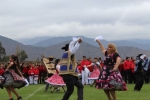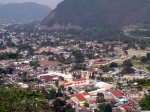Information about Nogales
The name of the district goes back to its origins as a commune. There in the center of the town of walnut trees. In this way, people started to use these trees as the name of the town.
The Nogales community consists of two districts: the District of Nogales (county capital) and the district of El Melon.
The name of the district goes back to its origins as a commune. There in the center of the town of walnut trees. In this way, people started to use these trees as the name of the town.
According to data collected in the Census, National Institute of Statistics, the township has an area of 405 km2 and a population of 21,633 inhabitants, 10,847 of them are women and 10,786 men.
Nogales hosts to 1.40 of the total population of the region. A 13.57 (2,935 inhabitants) is for rural population and 86.43 (18,698 population) to urban population.
The town of El Melon is rich in mineral deposits of copper and limestone. Copper is extracted with Anglo American Chile El Soldado division, which gives its name to the closed-pit mine. In contrast, the limestone deposit is mined by the company Cemento Melon, which carries the material to the city of La Calera, where it is processed and marketed through a freight train. This train is traditionally called "Calero".
Another resource is agriculture, the commune has fertile land where many products are harvested.
The municipality of Nogales was born geographical name, the place for the Seventh Subdelegation Quillota, November 2, 1878, when Don Jose del Carmen Godoy Andreu in community with his brother Peter Eleuterio acquired from the estate of the brothers Cortes part of the estate liters.
In principle, allocated the land lords Godoy agriculture, without more houses than occupied by them and necessary for farmers in need in their work; the whole of this property is called "NOGALES, because there is a tree of this species very lush that was rooted to the public roadside about 30 Mts. north of the present church on the sidewalk in front.
This name is then absorbed the Hacienda Los Nogales, due to the large commercial and mining boom that took, the population grew rapidly and it became necessary to create emails and telephones came to bear the name "Los Nogales" as sub - 15 of the Department. Quillota, with a population greater than thousand people.
Since its inception the district has gradually evolved, gaining special importance to the mining boom that began with the exploitation of minerals and Mines Copper Vessel, which was given further impetus to its growth, apart from the exploitation of agriculture which together form the basic wealth of the commune.
In 1876 he discovered other copper mines in addition to the already developed limestone. At that time there was a population of approximately 1,500 people, thereby taking the melon identity anger among hills where you run the operations.
At the beginning of the century (1906), begins a new phase for this area, because born melon cement company, which employed large numbers of people, so that the population increased and stabilized. Thus, as in many mining areas in the settlement and occupation of land was spontaneously moving towards the hills and ravines.
Within this historical context - becomes relevant to mention cultural Mrs Elizabeth Brown who was instrumental in the development of the commune at the beginning of the century, actively collaborating with the community to the date of his death in 1942, she must be countless advances in educational and religious materials. His works include the St. Elizabeth of Hungary Parish (Declared National Historic Landmark and today her little school Liceo Felipe Cortes.
Source: http://www.nogaleschile.cl/




